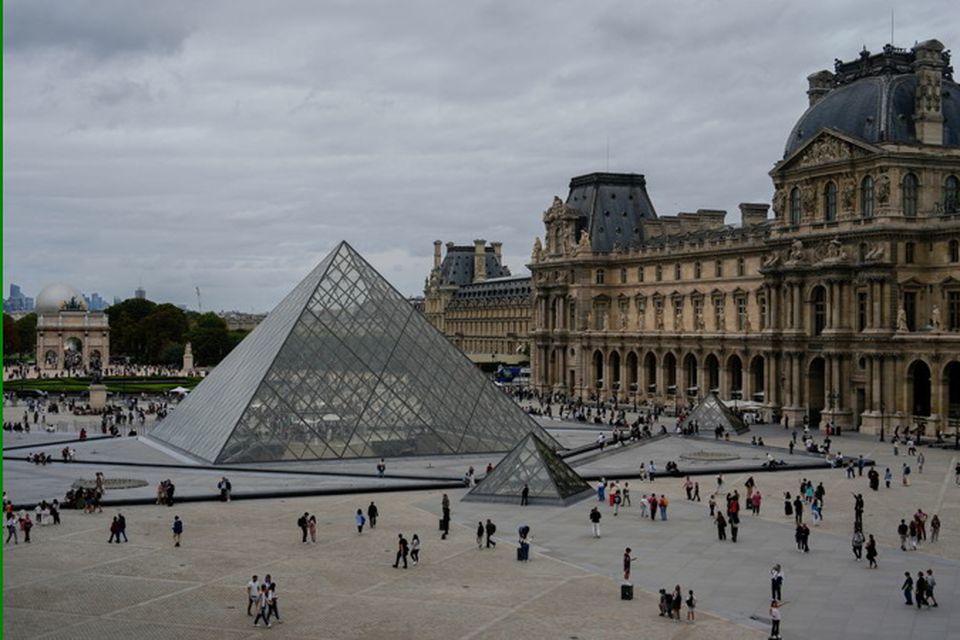World
Thieves Execute Daylight Heist at Louvre, Stealing Priceless Jewels

Thieves executed a bold heist at the Louvre Museum in Paris on March 3, 2024, stealing priceless jewellery from the gallery that houses the French crown jewels. Using a crane, they smashed a window on the upper floor and escaped on motorbikes shortly after the museum opened to the public at 9:00 a.m. (0800 GMT). The French government confirmed the break-in, which is likely to raise significant concerns regarding the museum’s security measures.
The robbery took place in the Galerie d’Apollon, a highly secured area known for its historical artefacts. According to Culture Minister Rachida Dati, the entire operation lasted approximately four minutes, indicating a level of professionalism from the thieves. “They entered calmly, smashed display cases, took their loot, and left,” she commented during an interview with TF1.
One item was recovered outside the museum, reportedly a broken piece of jewellery believed to be the crown of Napoleon III’s wife, Empress Eugénie. Minister Dati did not disclose specific details about the recovered item, but local media, including Le Parisien, confirmed its identity.
Security Concerns Intensified
Interior Minister Laurent Nunez stated that three or four thieves were involved in the heist. They accessed the museum using a crane positioned on a truck, demonstrating a planned approach to the break-in. “They broke a window, headed to several display cases, and stole jewels that have a real historical, priceless value,” Nunez explained during a broadcast on France Inter.
The heist raised alarms about security protocols at the Louvre, which welcomed 8.7 million visitors in 2024. In recent months, museum officials had already alerted the French government about the need for increased investment to safeguard its treasures. Dati emphasized that security had not been a priority for decades, noting, “For 40 years, there was little focus on securing these major museums, and two years ago, the president of the Louvre requested a security audit from the police prefect.”
Investigation Launched
Following the theft, a specialized police unit known for successfully solving high-profile robberies has begun an investigation. No injuries were reported during the incident, and the museum closed for the day due to “exceptional reasons.” A video shared on social media showed visitors evacuating the museum, initially unaware of the ongoing heist.
The Louvre, renowned as the world’s most-visited museum and home to masterpieces like Leonardo da Vinci’s Mona Lisa, has a history of thefts, including the famous 1911 incident in which the Mona Lisa was stolen by a former employee. It was returned two years later.
Earlier this year, Louvre officials had made urgent appeals for government assistance to restore and renovate aging exhibition halls and enhance security measures. The recent robbery underscores the pressing need for museums to adapt to evolving criminal tactics, particularly organized crime. “Today, it’s organized crime—professionals,” Dati remarked, highlighting the seriousness of the threat faced by cultural institutions.
As investigations continue, questions about the effectiveness of security measures at one of the world’s most iconic museums remain at the forefront of public discourse.
-

 Top Stories2 months ago
Top Stories2 months agoTributes Surge for 9-Year-Old Leon Briody After Cancer Battle
-

 Entertainment3 months ago
Entertainment3 months agoAimee Osbourne Joins Family for Emotional Tribute to Ozzy
-

 Politics3 months ago
Politics3 months agoDanny Healy-Rae Considers Complaint After Altercation with Garda
-

 Top Stories3 months ago
Top Stories3 months agoIreland Enjoys Summer Heat as Hurricane Erin Approaches Atlantic
-

 World4 months ago
World4 months agoHawaii Commemorates 80 Years Since Hiroshima Bombing with Ceremony
-

 Top Stories4 months ago
Top Stories4 months agoFianna Fáil TDs Urgently Consider Maire Geoghegan-Quinn for Presidency
-

 Top Stories2 months ago
Top Stories2 months agoNewcastle West Woman Patricia Foley Found Safe After Urgent Search
-

 World4 months ago
World4 months agoGaza Aid Distribution Tragedy: 20 Killed Amid Ongoing Violence
-

 World4 months ago
World4 months agoCouple Convicted of Murdering Two-Year-Old Grandson in Wales
-

 Top Stories3 months ago
Top Stories3 months agoHike Donegal’s Errigal Mountain NOW for Unforgettable Summer Views
-

 Top Stories3 months ago
Top Stories3 months agoClimbing Errigal: A Must-Do Summer Adventure in Donegal
-

 World4 months ago
World4 months agoAristocrat Constance Marten and Partner Convicted of Infant Murder









